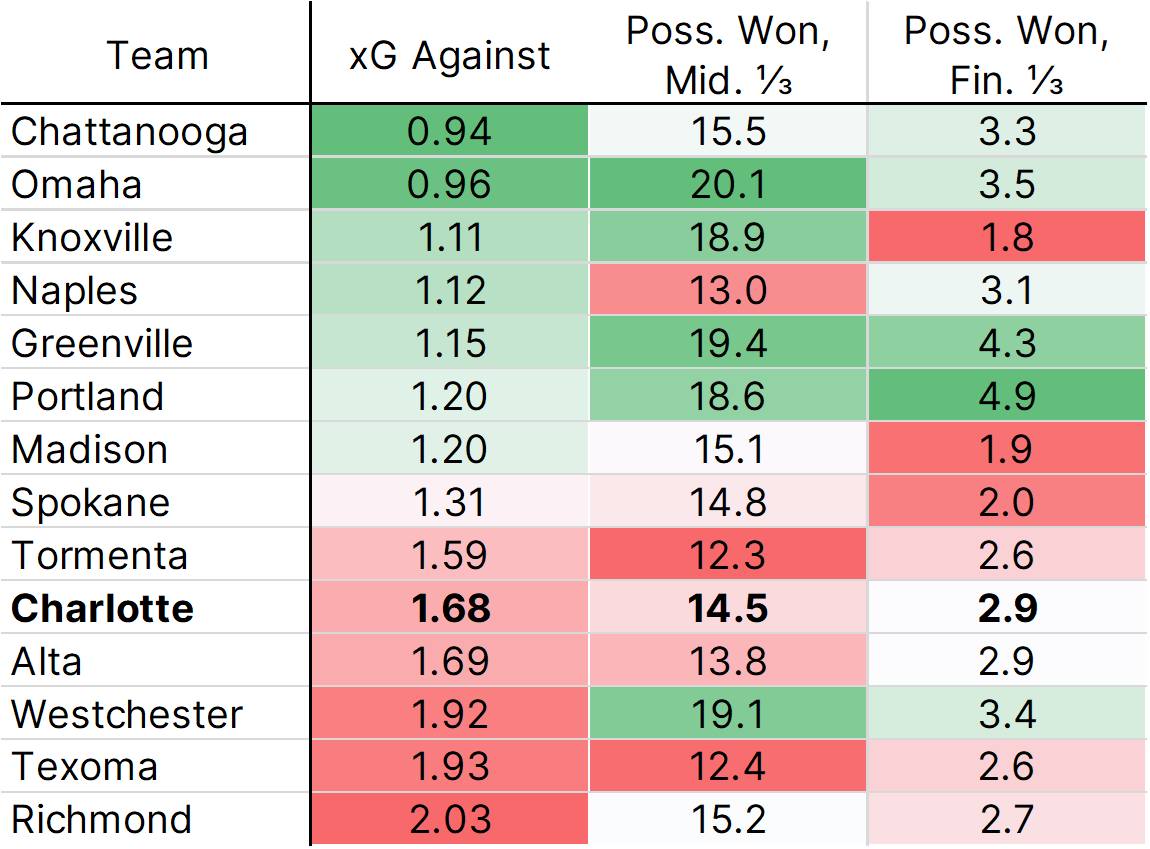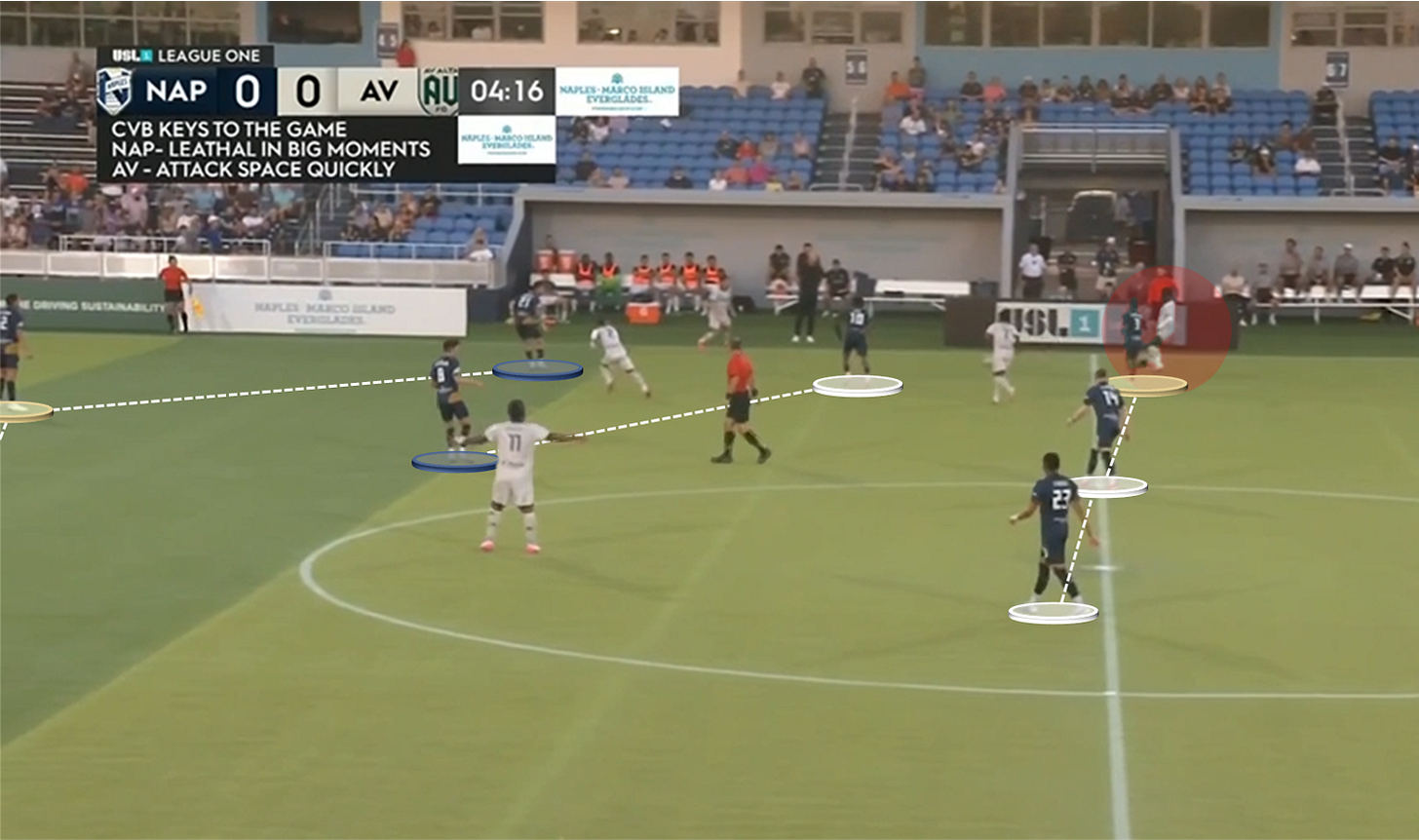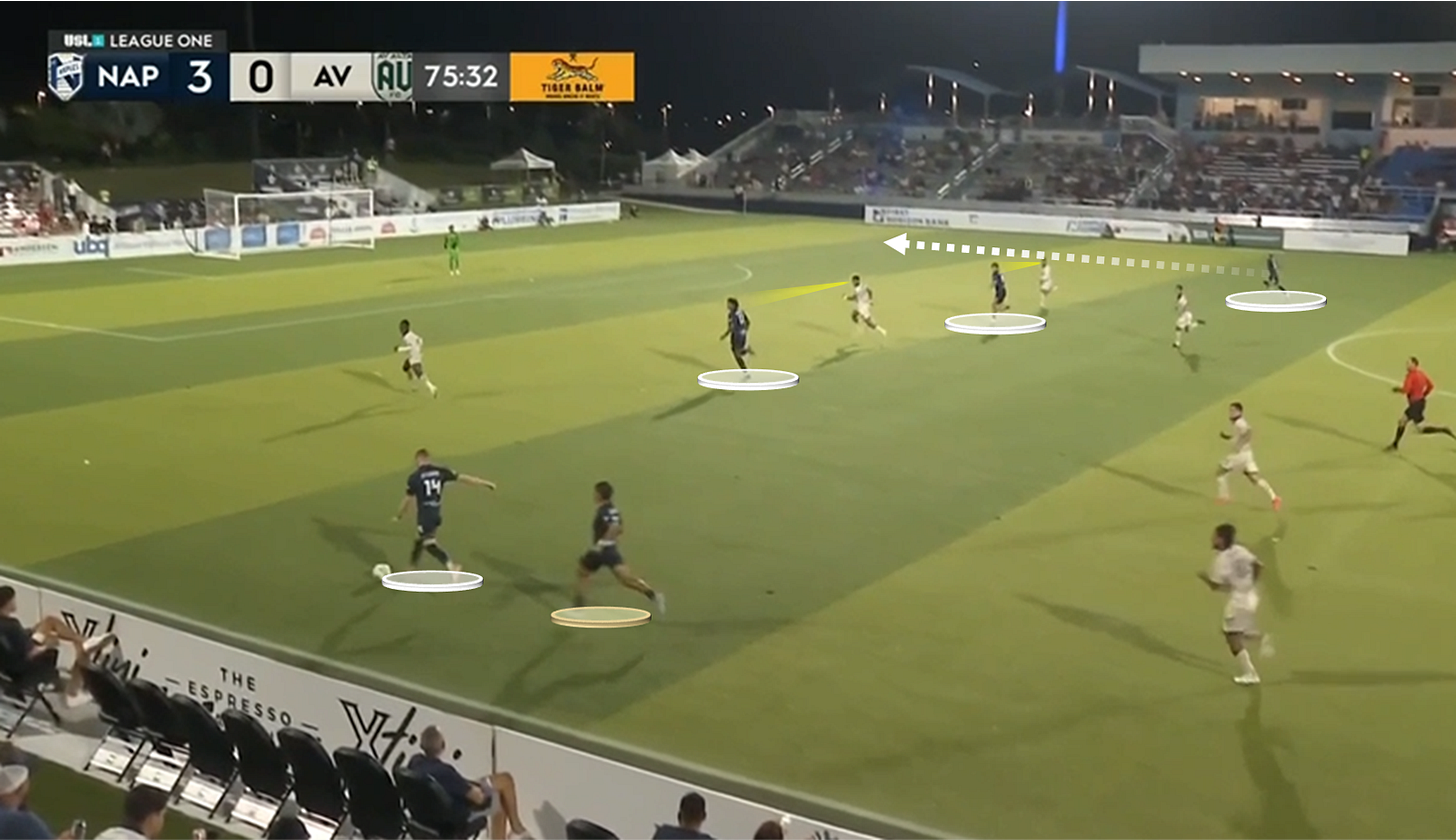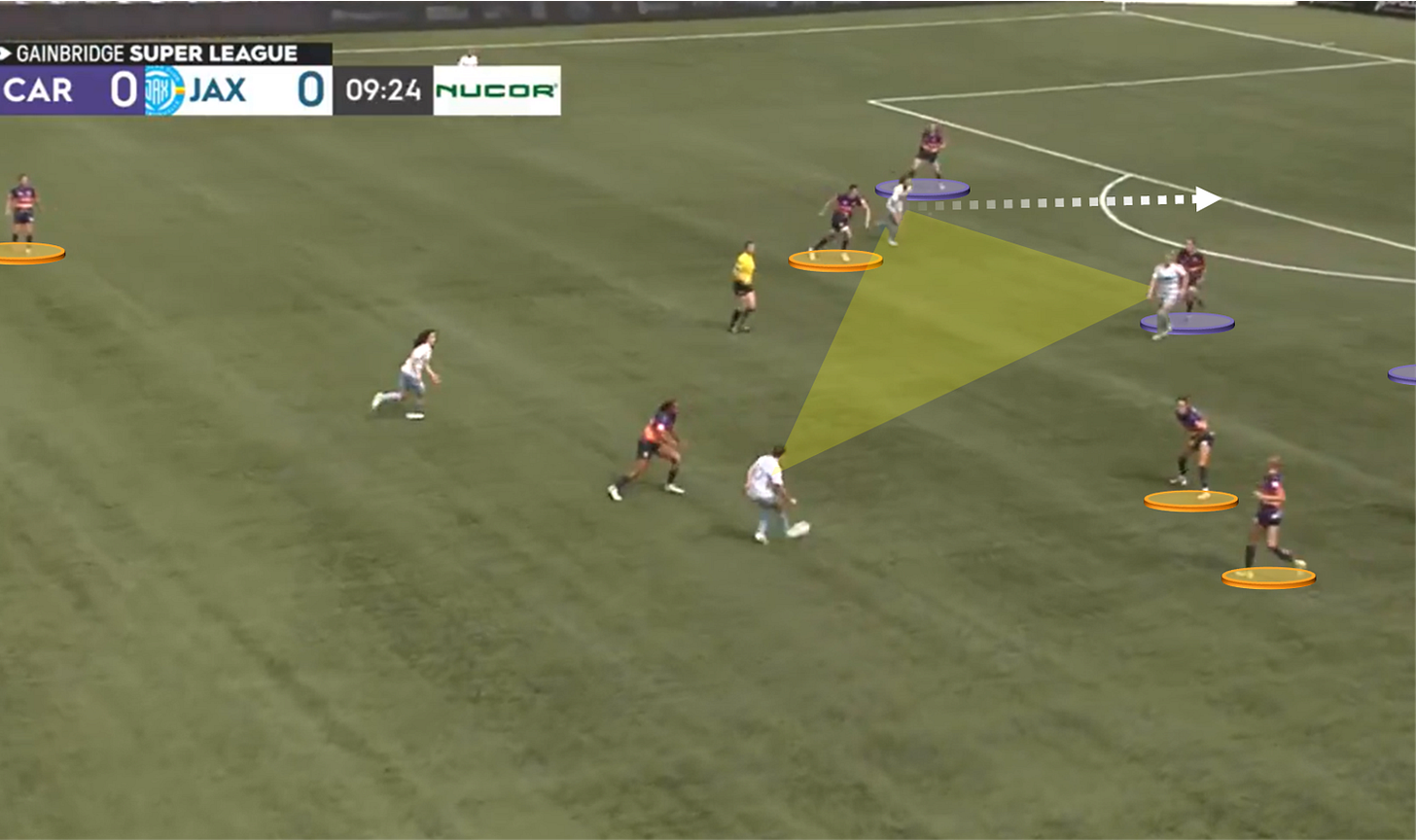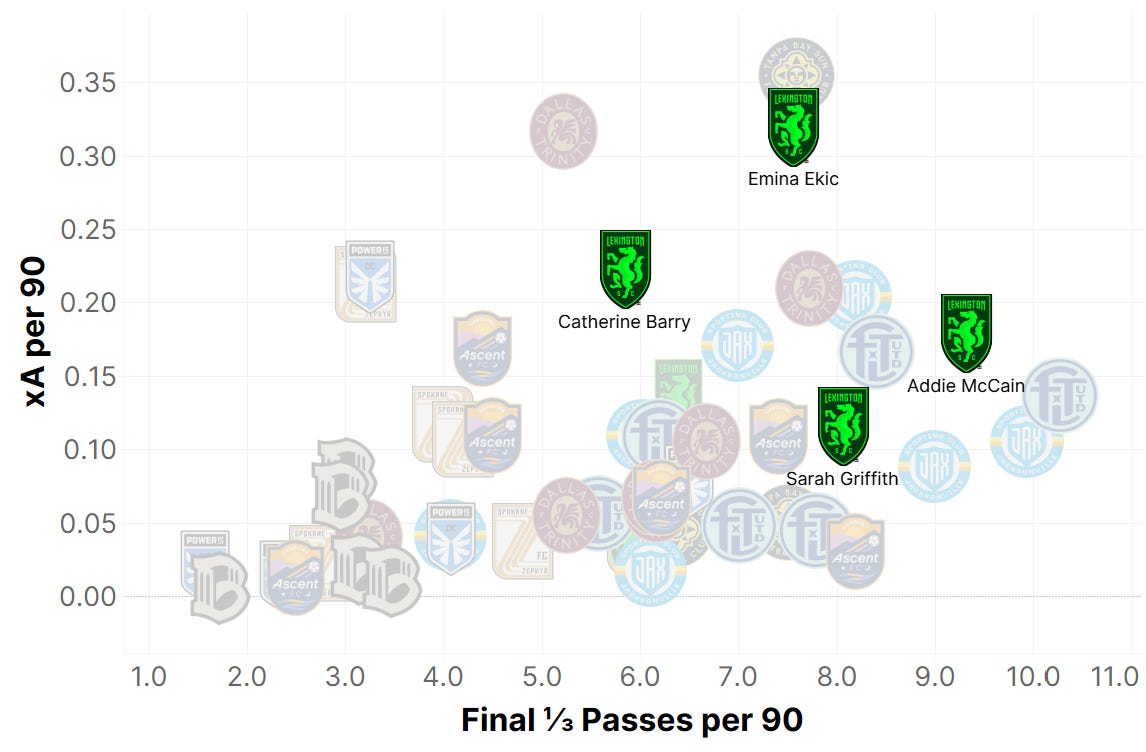The Back Four: Alternative awards
Featuring Charleston, League One's bubble, made-up awards, and more USL miscellany
Welcome in to The Back Four!
As always, check out Backheeled for more USL content, including a US Open Cup final. Also, check out This League! for an audiovisual dive into the week that was.
Without further ado, let’s get to it.
Changeable Charleston
Charleston was always going to be a playoff team. Under Ben Pirmann, the Battery have perennially competed for the Players’ Shield, and that wasn’t going to change in 2025.
Nothing is guaranteed in the USL, but when you’re a safe bet to lock down a home playoff game, you’ve got room to experiment. Pirmann has done so as the season reaches its denouement, and Charleston will be a more formidable team in the postseason because of it.
Last weekend’s draw in Orange County spotlighted two big shifts: Douglas Martinez’s unexpected resurgence as a right back, and Houssou Landry’s attacking freedom. Both facets came in complement to Juan David Torres on the right wing, and they’re useful arrows in the Charleston quiver even if they aren’t necessarily permanent stylistic pillars.
Start with Martinez, a career forward who’s now been re-cast as a defender. The Honduran international completed 60 of his 66 passes in California and attempted six crosses, but he never abdicated his defensive responsibilities. Martinez chipped in eight recoveries and was dribbled past just once, faring extremely well in one-on-ones.
You’re seeing Martinez in the spotlight here, breaking forward within Charleston’s 4-2-2-2 shape. As Orange County works from one side to the other, Torres closes down and forces a rushed pass that yields a heavy touch. At that point, Martinez pounces. The right back takes the ball away and dribbles upfield, giving Charleston a five-man counter.
Because Martinez cut out the opposing left back, the Battery have a localized overload against a shorthanded defense and a force reaction toward the Charleston right. As OCSC rotate, they open themselves up to an Aaron Molloy shot from the center of the pitch.
It maybe isn’t the highest-quality look, but it’s an exemplary break that illustrates Martinez’s defensive-into-offense upside as a fullback. The dynamic he creates alongside Juan David Torres is hugely promising.
The thing about Torres is that he’s a wanderer, and I mean that as a high compliment. The Colombian international loves to tuck inside for central touches, and he’s incredibly adept at maximizing his left foot in those positions. This year, he’s tended to drop low to seek out the ball as well.
All of those tendencies are useful, and Pirmann (probably) wouldn’t have it any other way. Still, when Torres drifts, it means that the right sideline is empty by default and needs a replacement runner. On Saturday, Martinez tended to be the player who would advance to fill that spot. Still, Landry also took his turn doing the same.
Landry has been a Swiss Army knife across 2025. He was signed as a No. 6 but has held down both fullback spots with some regularity. Against Orange County, he had the freedom to push into the opposing half like an out-and-out attacker.
In this case, Martinez is low as Charleston builds out, and he’s facing pressure from an OCSC winger. Torres drops low in support, and he attracts the man-to-man attention of a fullback in the act. Suddenly, there’s an opening on the right side.
Enter Landry. The former New Mexico United star streaks up the now-vacant right flank to essentially recreate Charleston’s baseline 4-2-2-2 shape. When the Battery hit a long ball, Landry is thus in position to run behind to meet a flicked-on header from MD Myers. Moments later, Landry will slip Cal Jennings in for a shot; he ended up creating two chances and completing 18 of his 20 final-third passes.
To accuse Charleston of being stodgy and rigid would be fundamentally incorrect, but this level of fluidity feels different. Both Martinez and Landry are players with specific track records in the USL, but both have evolved in 2025 to make the Battery that much more multi-faceted. It’s impressive stuff, and it’s going to matter in the postseason.
Knoxville - Charlotte
Since the start of August, the Charlotte Independence have lost their spark. They’ve won just twice in that period, and my modeling now gives them a good-not-great 61% chance of making the playoffs, lodged at the #8 spot. What felt like a sure thing is no longer so.
We’ll get to the ways that Knoxville succeeded against the Independence last Friday, but it’s useful to understand what they were coming up against. Let’s take a look at some defensive numbers across League One since Charlotte’s skid began:
The Independence have been a bottom-five team in terms of xG against and midfield recoveries in that time span, and their high press has middled. That’s a far cry from the first 17 matches of the year, when Charlotte allowed 27% less xG per match and took the ball back in the midfield 20% more often.
This team hasn’t really overhauled their system, still blurring lines between a back four and back five based on Rafael Jauregui’s positioning on the right. What’s changed is a willingness to sit in mid-low block to an even greater degree than we’ve become accustomed to.
Ian Fuller and One Knox knew what was coming, and they shifted their midfield to maximize opportunities against the current iteration of Charlotte. You might look at the xG numbers and assume it’s easy to work through the Independence, but that isn’t correct. As such, Knoxville used Angelo Kelly, Abel Caputo, and Kempes Tekiela to blend technique, mettle, and cleverness on the edge of the box. If One Knox could win a second ball and break, they were in business. Likewise, if they could force an overreaction out of Charlotte’s 5-2-3, they were similarly able to work through.
In the 11th minute, a simple bounce pass between Caputo and defender Jordan Skelton attracted the attention of Charlotte defensive midfielder Omar Ciss, thereby creating a hole in Charlotte’s 5-2-3ish structure. There was a certain aspect of 5-1-3-1 to the design, but it (probably?) didn’t involve full-throated pressure from a No. 6 flying at a center back.
Working around the edge after that step, Knoxville could find Gio Calixtro dropping in from the left wing of their 4-2-3-1. That run further unsettled the defense, forcing both Clay Dimick (a right-sided defender) and Jauregeui (wingback-ish) to step. Hopefully, you’re imagining the dominos falling: Charlotte overcommitted up their center and right sides.
The result? A stellar switch from Caputo toward right winger Mark Doyle on the far sideline, a header into Tekiela in a one-on-one, and a golden look at goal. Contrary to the numbers, it was a case of Charlotte actually trying to press but destabilizing themselves in doing so.
Knoxville’s somewhat unbalanced shape was designed to test Charlotte in numerous ways. Jaheim Brown might’ve been the player that ultimately scored the winning goal, but the right back was happy to sit low in build as Stuart Ritchie flexed up the left to create something closer to a 3-2-5.
Here, you can see that low base of five players (three center backs, two center mids) set the table. The utility is obvious: the Independence’s high 5-1-3-1 press has four dangerous players upfield, so the 3-2-5 naturally gives Knoxville an extra set of feet at the back. As such, Sivert Haugli can find the edge from the left side of the defensive line and hit Gio Calixtro in the halfspace.
Calixtro is narrow to accommodate Ritchie’s overlapping advance, and he opts to cut in and find Kempes Tekiela at his feet. In the process of that move, Knoxville draws Charlotte’s back line extremely narrow. Despite that horizontal compactness, Tekiela is given too much room to dribble. He’ll circle the wagons, find Ritchie, and set up a dangerous cross.
Even before Charlotte went down a man, chances like these abounded. Between the slick offensive patterns and an effective counterpress led by Kelly, One Knox was able to dominate territory and run up a 1.60 to 0.25 xG margin. Meanwhile, the resting back three-ish base limited what players like Christian Chaney could do as transition sparkplugs.
If you refer back to that post-July defensible table, you’ll note that One Knox is near the top of League One in terms of their xG record and midfield recoveries. You saw all the reasons behind those successes on Friday. Knoxville limited concessions with a considerate possession game, and they controlled play through the midfield on both sides of the ball. It’s why they’ve clinched a playoff spot and why Charlotte still feels heat around the corner.
Naples - Alta
Naples and Antelope Valley are on opposite sides of the expansion coin. Naples averages the second-least passes per possession (3.3) in League One, while Alta is first (5.2) by a comfortable margin. Matt Poland’s side advances play by nearly nine yards per pass, while Brian Kleiban’s only move the proverbial chains by 5.1 yards in a given attempt.
Beyond the opposing profiles, FC Naples is trending up while their first-year peers are dropping down the table. The two teams met last weekend, and it couldn’t have been clearer that Naples’ higher-octane tactical system had the edge. In the end, it clinched the Floridians a playoff spot.
Naples’ high 4-2-3-1ish press dictated how the match was played. Alta held 67% of the possession, but their field tilt was merely 62%, and they finished with less touches in the box than their hosts. At every step, Naples’ shape stalled opposing pass sequences and made it extremely difficult to access the central areas.
Plenty of teams can defend well while set in their base shape, but Naples’ rotations were pitch-perfect on Saturday. You can see a version of the 4-2-3-1 above, but the makeup of it – altered in the act of tracking Alta runners – is completely wonky.
In this case, Alta forward Jerry Desdunes has cut toward the sideline, attracting attention from fullback Julian Cisneros on the Naples side. Meanwhile, Christian Ortiz makes a run upfield from right back to replace Desdunes, so he’s being followed by Marc Torrellas out of the Naples pivot.
Alta can’t advance despite the sharp movement because Naples is so shapely; it’s a side-shifted 4-2-3-1, but you’ve effectively got Torrellas as the left back, Cisneros as the winger, and Jayden Onen filling between them like a No. 8.
These sorts of sequences were commonplace, but Naples didn’t rest on their laurels. Instead, they used their weak-side wingers in an aggressive manner whenever play switched from side to side.
Consider that frame above once again. Alta’s natural reaction will be to reset and work to the opposite side. When that happened – and it happened a lot because of those wonderful rotations – either Onen or right-sided Andres Ferrin would ferociously attempt to intercept. That manner of defending put Naples on the board in the 28th minute, with Onen picking up the takeaway to spark a break.
If Alta wanted to go long over the press, they didn’t have the pieces in place to do it. Cerritos (5’11”) and Desdunes (5’7”) combined to attempt just three aerial duels, meaning that their side played into the gaping maw of the Naples defense almost exclusively.
In the other direction, Poland’s unit built in something like a 2-2-5-1, anchoring Torrellas and Chris Heckenberg ahead of the center backs at the base of the shape. In the attacking band, the fullbacks and wingers were fairly free to change places, and the connection between Ferrin and right back Max Glasser was especially impressive in that regard. The duo combined to attempt seven crosses, and Ferrin alone tried eight dribbles; their ability to break through forced Alta to completely re-tool their right side coming out of halftime.
As Alta extended further and further upfield, they left themselves more and more open against the break. We briefly highlighted Ortiz’s forward movement in the rotation example; that tendency to hinge the fullbacks high upfield is definitional to Antelope Valley’s offense. Here, though, it’s leaving them extremely vulnerable on the counter.
Above, Naples has broken past the opposing right back and is about to enter the final third with an effective five-on-three. Kevin O’Connor – who did immense defensive work as the No. 10 – carries the ball forward, with Cisneros overlapping him. Because Naples has two central runners, O’Connor will be able to pick out Ian Cerro at the far side to put Naples up 4-0.
Naples was clinical in these sorts of situations, which is a precondition for beating Alta. Antelope Valley is dead last in League One with 0.28 fastbreak xG allowed per match, and Poland’s side knew it.
Pitting these two against one another as bastions of pure pragmatism and extreme inflexibility would be hyperbolic, but only just. Naples’ strength this season lies in their adherence to a counter-driven, pressureful 4-2-3-1. Still, they’re adaptable in a way that Alta simply hasn’t been. Finding that middle ground is key in the USL, and it explains where these expansion clubs sit in the playoff race.
Super League potpourri
The Carolina Ascent are flailing. After allowing four goals against Jacksonville on Sunday, it’s worth examining what’s gone astray in Charlotte.
Last year, it took the entirety of the fall for Phillip Poole’s side to concede 11 goals. Literally! They didn’t get there until December 14th! They’ve already hit that marker in the 2025 campaign, and the calendar is only just turning to October.
Poole prefers to run a defensive 4-4-2, as is the vogue across much of world soccer. The best adherents of that shape minimize space between their lines and tend to use zonal principles to stay shapely. At critical points, by contrast, Carolina is chasing the ball, sacrificing their structure, and suffering because of it.
We got a hint of that problem last Wednesday against Spokane, where handoffs between the wingers and center mids within the midfield line were problematic. If Zephyr let a wide player dribble inside, the Ascent didn’t know how to cover it; their pivot pairing of Sydney Studer and Taylor Porter didn’t tend to step up in the tackle, and backpressure wasn’t forthcoming. It let Spokane find through balls from the center of the pitch with concerning ease.
Against Jacksonville, Porter stayed central, but Studer was replaced by Sarah Troccoli and both wingers were changed out. The result was even worse.
You’re seeing the immediate lead-up to Jacksonville’s first goal here, and the problems are obvious. Wide defender Julia Lester has dribbled into the pocket for Jacksonville, but none of Carolina’s midfielders are closing down. Mia Corbin – a player that blends No. 9 and No. 10 roles – belatedly shows toward the carrier, but not before Lester looks upfield and finds forward Jade Pennock.
Pennock draws defensive pressure on her back, meaning that the Ascent’s back four has suddenly lost its structure. You can already see Ashlyn Puerta streaking inside from a baseline left-side position, seeking out the vacant space. She’ll score just seconds after this screenshot, well on the way to a first-half hat trick.
Jacksonville looked wonderfully incisive, but they took advantage of a defensive shortcoming that’s impossible to ignore on the Carolina side of things. Between the bafflingly lax posture of the 4-4-2 and a deleterious tendency toward risky backpasses, the Ascent are getting in their own way in 2025.
Meanwhile, Lexington is showing how effective an attacking 4-4-2 can be. Their six-goal explosion against Dallas last Friday is the result of the season so far, and it highlighted just how perfectly LSC’s offseason rebuild has gone under Masaki Hemmi.
Lexington didn’t just take it to Trinity; they put up 17 shots in the box, attempted more than 100 passes in the final third on 70% accuracy, and won a narrow majority of recoveries. The fluidity across the front four gave Dallas fits, challenging their phase-based defensive shape at every turn.
In a sense, it was par for the course. So far this fall, Emina Ekic, Catherine Barry, and Addie McCain have all placed as top-ten players for xA per game in the Super League. McCain and Sarah Griffith, meanwhile, respectively rank third and eighth in terms of total passes in the final third. This team is incredibly active when they’re close to the 18-yard box, and they’ve got four technicians between the wing and forward spots that have been a model of efficiency.
You saw those skills shine last week. Lexington’s second goal saw Ekic unselfishly drop between the lines, flicking the ball on with the Trinity overcommitting to her run. Meanwhile, McCain made an all-important replacement move to the right wing, allowing her to receive in the box to score. McCain is best known for her No. 10-esque facilitation, but she’s shining with more verticality and freedom in Kentucky.
Merely six minutes after that strike, LSC sped play up with a quick throw over Cyera Hintzen – the hinge player between back three and back four in the Trinity system – to loose McCain in the right pocket once more. This time, she set the table for Griffith to streak into the box, forcing the remainder of the Dallas defense to rush toward the endline. Thus, the cutback was on to Barry, who wisely held her run until Trinity had committed their momentum.
When you see LSC play, it’s not entirely surprising to see them drop six goals at a time. The talent level in Lexington is tremendous, but Hemmi has forged his stars into a fully coherent system that’s a joy to behold. After only six weeks, Lexington has a level of spatial understanding within their 4-4-2 that’s made them the odds-on title favorite.
Alternative Awards
If you’re looking for normal USL awards picks, you can check out last week’s Backheeled column. Here, I want to do something a little different.
If you’ve made it to the USL level, you’ve probably got some high-caliber skill that ought to be recognized. I can’t shout out all 1,000ish players across the Championship and League One, but I want to dig into a few alternative awards that can highlight some of those unsung stars. Let’s dig in.
The Selke Trophy
Inspired by the NHL’s award for the forward with the greatest defensive contributions.
FC Tulsa is en route to the #1 seed in the West because of their defensive excellence, and Taylor Calheira is the tip of that spear. He’s an 80th percentile forward in terms of duel wins (six per game) and also makes 0.8 final-third recoveries in the average match. All that energy is used to underpin an aggressive 3-4-3 press – and Calheira still has 12 goals on top of the defensive effort! Also considered: Robbie Mertz, who’s putting up 1.7 tackles and 4.2 recoveries per match as a proper winger, as well as Russell Cicerone, who’s bettering Calheira with 91st percentile final-third regains but loses out ever so slightly by the eye test.
At risk of doing a “2015 Atlanta Hawks,” I’m splitting the League One trophy between teammates. Chattanooga’s Matt Bentley (2.3 recoveries and 1.1 takeaways per game as a striker) and Pedro Hernandez (2.1 aerial wins, unreal work rate) are sharing the honor. Across the regular season, they’ve played nearly 900 minutes next to one another. The Red Wolves have smothered their opponents during that time, conceding just nine goals as Bentley and Hernandez have combined to make a tick under 1.2 final-third recoveries per 90 minutes.
The honorable mentions? Leo Castro is an ageless wonder in Greenville, one that combines shoulder-to-shoulder physicality with unreal spirit as a presser. He’d have won this thing if he didn’t get hurt in the late summer. Up in Portland, Titus Washington (93rd percentile final-third takeaways) was also in the mix; I would turn the ball over instantly if I saw Washington charging at me.
Cup Goalkeeper of the Year
Awarded to the goalkeeper that stood out in cup competitions.
There’s only one pick here: Sacramento’s Jared Mazzola. The Republic standout hasn’t played a single minute in the league, but he’s been the go-to in both the Jagermeister Cup and US Open Cups. Mazzola has allowed an unbelievable 0.38 goals per 90 in those eight starts, contributing to six clean sheets all the while. No goalkeeper can better Mazzola’s 2.5 goals prevented in the Jagermeister Cup, and that’s not inclusive of his penalty shootout against Loudoun in the semifinals.
I’d be remiss not to shout out Hugo Fauroux. He’s second behind Mazzola in goals prevented in intra-league cup play, and we’d be having a different conversation if that fateful shoutout against the Republic had gone a little differently.
12th Man of the Year
Awarded to the player who made the greatest impact off the bench.
Hartford’s Kyle Edwards is the runaway pick here. Edwards has started seven games and scored a highly respectable four goals in that time. In 341 bench minutes, the striker has struck seven times – that’s far more than 1.0 goals per 90 minutes. Hartford has succeeded for a lot of reasons this year, but the St. Vincent international’s substitute heroics can’t be overlooked. Ditto for Tulsa’s Stefan Lukic, the runner-up. The League One graduate has provided unique target-man chops off the bench, and he’s got four goals this season while making a whopping 18 substitute appearances.
In League One, Charlotte’s Souiabou Marou leads the pack. The winger has six substitute goals so far, and while he’s a bit feast-or-famine, Marou has made a significant impact in his 16 cameos off the bench. If you’re looking for an impact defensive sub, then Greenville’s DJ Benton is your man. While Benton has started a number of matches recently, 63% of his minutes have come off the bench. Whether operating as a right back or central defender, Greenville concedes just 0.89 goals per 90 with Benton on the field versus 1.49 when he sits.
Rookie of the Year
Given to the first-year player, preferably a college product, that made the greatest impact.
Josh Jones should be an all-league defender for Louisville City, so he’s naturally going to be the pick here. Jones has held down the right and center positions of his team’s back three without missing a beat, displacing former USL Defender of the Year Arturo Ordonez in the process. Between his long throws, his 68% duel win rate, and his league-best 4.9 aerial wins per game, Jones has done everything right after signing out of the University of Louisville. Elsewhere, Pittsburgh’s Guillaume Vacter (UConn) and Beto Ydrach (Akron) have been similarly implacable in defense; the same could be said for TJ Presthus (Yale) up in Hartford.
Connor Evans is the runaway pick in League One. The Portland-by-way-of-Stanford rookie has played left, right, and center for the Triumph and has been consistently impactful no matter his position. Evans is the premier set-piece taker in League One; he’s created 36 chances from dead balls, twice as many as any other player! On top of that, Evans is top-25 in terms of open-play chances created and interceptions, all while seamlessly filling any and all positions in the Greenville system.
The choices elsewhere in League One are hugely exciting. The aforementioned Titus Washington (Seattle) has impressed as Hearts of Pine’s top No. 9, and Yaniv Bazini (Vermont) has done the same for Tormenta. Mikkel Goling (UCSB) brings an energy and transition impetus that’s definitional for Knoxville, while fullback Julian Cisneros (Loyola Chicago) is the textbook definition of “dawg” down in Naples.
Bottom-of-the-table MVP
Couldn’t think of a decent title here! It’s the best players from bad teams!
Westchester is almost certain to finish in last place, and that’s despite a Herculean effort from JC Obregon. After following Dave Carton from Charlotte, Obregon has 14 goals and is on pace to win the Golden Boot. He’s done so while taking a league-high 126 box touches, mixing in that classic No. 9’s presence with a sterling ability to combine with teammates on the drop. Moreover, Obregon’s xG on target (16.4) exceeds his naive xG (15.5), evidence of absolute top-class finishing.
In a sheer “this guy is so, so, so fun” sense, Ajmeer Spengler deserves a shout. He’s been good for 2.7 xA, 3.4 xG, and 59 dribble attempts for Texoma, anchoring their press-and-break peaks. It might be rude to call Madison straight-up bad, but this is my only space to praise Jake Crull, perennially one of my League One favorites as an elbowing left-sided defender.
This is a fundamentally difficult exercise in the Championship because so few teams are entirely out of the playoff hunt, but last-place Las Vegas’ Gennaro Nigro captures the spirit of the award. What other left back is his team’s initiator? Nigro takes 63 touches per game, completed nearly four long balls a match, and has still contributed six assists despite those deep-lying duties. He’s a clean defender to boot, one that’s trustworthy after the ball turns over.
Monterey’s Wesley Fonguck drives like a sports car in the central midfield, and he’s one of the USL’s best passers under pressure. In Miami, Jonathan Ricketts has borne a defense-first deployment at both fullback spots and done extremely well; he’s good for 2.0 tackles, 1.5 interceptions, and 6.0 duel wins per game.
Quick Hits
In other news this week…
Be on the lookout for full Team of the Year picks in the near future, while we’re on the awards topic.
Greenville is firmly back in the playoff mix, and the 5-2-1-2 shape I covered last week is the reason why. Winning in Spokane is never easy, but the Triumph did as good a job as anyone in 2025 at putting a lid on their attack.
That formation creates natural trapping triangles up through the midfield, making halfspace entry hugely difficult. Say David Garcia (or Jalen Crisler) has the ball at the right-sided center back spot within Spokane’s 3-2-5. They’d want to hit Lucky Opara or skip into Shavon John-Brown, but those outlets were regularly walled off by the press. Garcia and Crisler only combined for three passes into John-Brown, and while their side did well to lean into a direct-and-press alternative, Greenville won the tactical war.
Dayonn Harris renaissance is in full effect. His speed up the left side and unreal eye for transitional breakaways – both as a tool of counterattacking offense and defensive zone exit – is why New Mexico is all but locked in for the playoffs. It’s wonderful seeing Harris finally break out.
Omaha, good lord! Winning at Chattanooga is difficult in the best of circumstances, but Vincenzo Candela’s side took it to the Red Wolves. The variation in Omaha’s shape stood out: offensively, they essentially went 2-3-5 and feasted with Charlie Ostrem, Stefano Pinho, and Ryan Becher (a No. 8 this time out) combining up the left, whilst a hyper-narrow 4-2-2-2 defense on restarts put a lid on Chattanooga’s second-ball dominance. Wonderfully tactical stuff.
New York Film Festival season is upon us. As someone who’s published about 10,000 words during each of the last 60-plus matchweeks, I pretty obviously don’t take big vacations. My sicko brain can’t handle it. What I can do is waste my PTO on movie premieres at the festival, hence why I got to see George Clooney chop it up with Noah Baumbach in a post-Jay Kelly Q&A (good movie!) and be in the same room with Idris Elba after A House of Dynamite (less good!).

